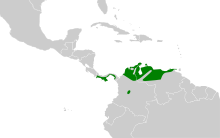| Lance-tailed manakin | |
|---|---|

| |
| Scientific classification | |
| Domain: | Eukaryota |
| Kingdom: | Animalia |
| Phylum: | Chordata |
| Class: | Aves |
| Order: | Passeriformes |
| Family: | Pipridae |
| Genus: | Chiroxiphia |
| Species: | C. lanceolata
|
| Binomial name | |
| Chiroxiphia lanceolata (Wagler, 1830)
| |

| |
The lance-tailed manakin (Chiroxiphia lanceolata) is a small passerine bird which breeds in tropical Central and South America from Costa Rica to northern Venezuela. This manakin is a fairly common bird of dry and moist deciduous forests, but not rainforest. It is a small, compact bird about 13 centimetres (5 in) long and similar to the blue-backed manakin, but both sexes have the two central tail feathers elongated to form a spike. Males have black plumage with a blue back, a red crown and orange legs. Females and juveniles are olive-green with paler underparts. At breeding time, males are involved in a cooperative behaviour during which they jump up and down alternately. This is a fairly common species with a wide range, and the International Union for Conservation of Nature has rated its conservation status as being of "least concern".
- ^ BirdLife International (2017). "Chiroxiphia lanceolata". IUCN Red List of Threatened Species. 2017: e.T22701074A110782974. doi:10.2305/IUCN.UK.2017-1.RLTS.T22701074A110782974.en. Retrieved 12 November 2021.
